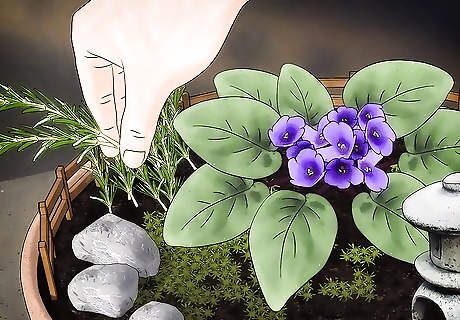
views
Gathering Your Supplies

Find a suitable container or pot. You can house your mini garden in a variety of containers, from a glass bowl to a plastic pot to a terracotta planters pot. You should look for a container that has drain holes at the bottom so the water drains through the soil when you water your mini garden. Terracotta pots are ideal, as they often come with drainage holes and are good for holding potting soil. Look for a terracotta pot that will hold several small plants, as you want your container to be big enough to house your mini garden. You may decide to repurpose a broken clay pot by using it for your mini garden, especially if it is only broken on one side. You can then prop the broken piece up and add it to your mini garden as a unique, fun feature.

Get potting soil and small stones. You will need regular potting soil to lay down at the bottom of your container. You can find potting soil at your local plant nursery or in the gardening section of your local hardware store. You should also pick up small stones of various colors and textures to lay down in your garden as decoration. If you are planning to a glass bowl to house your mini garden, you should get horticultural charcoal in addition to potting soil. The horticultural charcoal will help your plants grow better in the glass container. You can then lay down the horticultural charcoal and the stones at the bottom of your glass bowl or container.

Select plants for your mini garden. When it comes to selecting plants for your garden, you should go for plants that will stay small and require very little trimming. You should also choose plants that are easy to grow in a small space and that will produce attractive blooms. Possible plants for your mini garden include: Herbs like thyme, basil, rosemary, sage, lavender and oregano Lemon-scented geraniums Firecracker plants Dwarf licorice Marjoram Miniature orchids and miniature ferns Begonias Spider plants Moss and lichens Winter greens African violets
Putting in the Soil and the Plants

Put an even layer of potting soil in the terracotta pot. Start by rinsing and drying the container you are using for your mini garden. Fill the container with potting soil up to the rim. You can make the potting soil slightly higher on one side if you would like your plants to be visible from the side. Use a small knife or a small shovel to dig small holes for the roots of the plants. Space out the plants so they are not in one cluster in the pot. You may also want to lay out the mini garden before you plant anything by noting where you are going to place your plants and your accessories. You can then make holes in the potting soil based on your design.

Add small stones first if you’re using a glass container. If you are using a glass container, you should lay a one-inch (2.5 centimeter) layer of small stones on the bottom of the container first. This will ensure your plants get enough nutrients in the glass container. It will also help your plants drain properly. Then, add a half-inch (1.3 centimeter) layer of horticultural charcoal. Finally, add in a three to four inch (7.6-10.16 centimeter) layer of potting soil.

Prepare the plants for the container. Once you have laid down the soil, you will need to prepare the plants. This will ensure they grow healthy and beautiful in your mini garden. Start by taking the plants out of their pots. Avoid touching or breaking the root ball. Then, use small a pair of garden shears to trim any damaged leaves off the plants.

Put in the plants. Place the plants in the prepared holes. Once the plants are in place, pat soil over the roots. Try to place taller plants in the back of the garden and shorter plants in front. You should try to have a variety of plants in each area so your garden showcases interesting patterns and colors. If your container has a narrow opening, you can use a pair of chopsticks or the end of a long paintbrush to position your plants in the soil. Water the plants after you are done.
Adding Miniature Accessories

Find miniature accessories. You can get creative by putting miniature accessories among the plants in your mini garden. Almost anything can be used as an accessory in your garden, as long as it is miniature in size. You may also decide to add miniature structures to your garden, like a miniature bridge, a miniature fence, or a miniature set of tables and chairs. Maybe you decide to add in miniature figures and create a garden scene, complete with miniature food items. If you are going for a more minimal mini garden, you may decide to add simple elements like marbles, beads, or decorative pieces of wood.

Decorate the garden with rocks and figurines. Once your plants have been added, you can decorate the garden with rocks and figurines. Try out a few different accessories next to your plants to see what might work best. You may decide to accessorize with simple items like decorative rocks, twigs, and colored stones or marbles. Get creative and make the garden appear colorful and fun.

Accessorize based on a theme. If you are going for a certain theme for your garden, you may add in accessories that fit the theme. Decorating based on a theme can make your garden feel cohesive and artistic. One popular theme for mini gardens is a fairy-garden theme, complete with mini benches, mini rocking chairs, mini painted eggs, and mini garden gnomes. You may also go for a woodland garden look, complete with tree stumps, a mini wrought iron fence, and small fairy figurines.

Add a stone path. You can also add in a stone pathway in your garden for a more permanent accessory. You can use small stones to create a pathway or a mixture of stones and marbles. Use a small shovel to draw lines in the soil to mark where the pathway is going to go in the garden. Then, lay down the stones to form a path. Keep the stones close together so they form a pathway. Use stones of various colors or mix marbles with the stones to create a colorful pathway in your garden.
Caring for the Mini Garden

Keep the garden in indirect sunlight. Once you have completed your mini garden, you should place it outside or inside on a flat surface, like a table or the ground. Keep the garden in indirect sunlight so the plants still get some sun. If you are keeping the mini garden by a window facing south, place a window shade or a lightweight curtain over the window. This will block out any direct sunlight and only allow indirect light to filter in. South-facing windows with a shade or curtain may still provide too much light. You may decide to place the mini garden by an east or west-facing window, as this angle will provide enough indirect light for most of the year. Avoid north-facing windows. North-facing windows usually do not get enough indirect sunlight year round to sustain plants.

Water the plants when the soil feels dry. You should always check the soil in the mini garden periodically to ensure it is not too dry. Keep the soil damp by running water through the pot once the soil feels dry around the roots of the plants. Depending on the types of plants in your mini garden, you may have to water some plants more often than others. If there are any succulents in your mini garden, for example, they may not require as much watering as herbs or other plants in your garden. Make sure you follow the watering directions recommended on the label of the plant. If you used a glass bowl for your plants, water slowly. Stop when you see water reach the stones at the bottom of the bowl.

Trim the plants, as needed. As your mini garden grows and thrives, the leaves of some of your plants may start to overcrowd your container. To keep them under control, you should trim the plants using small gardening shears.




















Comments
0 comment